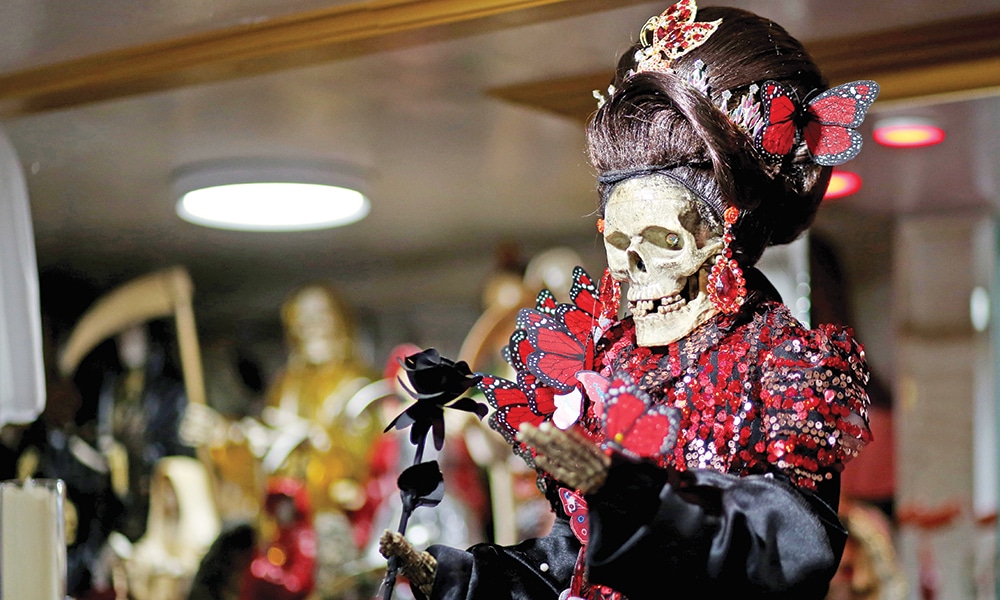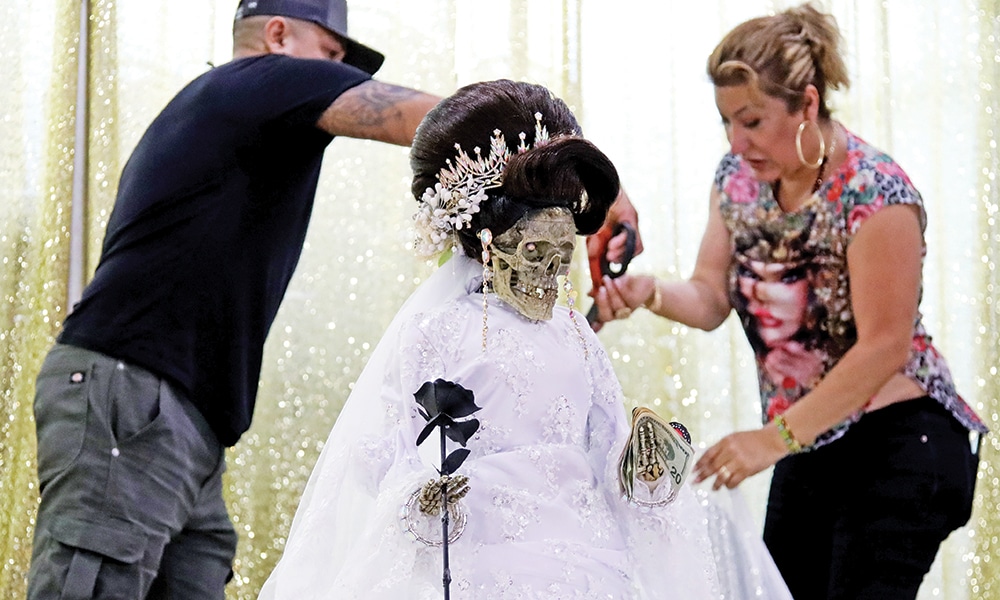Standing before an elaborate altar in her living room in New York, Arely Vazquez explains the pledge she made to Santa Muerte—or Saint Death—after surviving pancreas surgery 17 years ago: that she would honor her “little skeleton” by throwing a festival of thanksgiving each year. Vazquez is the main priest, or “madrina,” in the United States of a growing faction of devotees to the skeleton saint revered in Mexico, often alongside traditional Catholic saints.
She calls the movement a “faith, a devotion” that “helps us get out of difficult situations.” For her followers, Santa Muerte—often portrayed carrying a scythe, a globe or a rose—takes on special virtues or powers depending on her clothing and other characteristics.
Faithful from around the country convened before the altar at Vazquez’s annual festival in Queens this month, gathering for prayer, offerings and devotion and sharing stories of the many blessings granted to them by their bony benefactor. Many attendees donned images of Santa Muerte—in large gold pendants, rings and even tattoos.
There are no rules or strict requirements imposed on the followers of what Andrew Chesnut, a professor of religious studies at Virginia Commonwealth University, calls a “new religious movement, not a cult or sect,” which first gained popularity in Mexico City in 2001. According to Chestnut, the author of “Devoted to Death: Santa Muerte, the Skeleton Saint,” there are about 12 million devotees, mostly in Mexico, but also throughout the United States and Central America. “It’s the fastest growing new religious movement on the planet,” he told AFP via email.


‘Satanic’
Respect for mortality and the afterlife is already entrenched in Mexican culture, rooted in hundreds of years of Catholicism and Indigenous beliefs. Death is seen as an opportunity for new life. For many of her followers, the veneration of Santa Muerte was therefore a natural next step, though their devotions were until recently performed only in private.
And although the Mexican Catholic Church has repeatedly condemned Santa Muerte as “satanic,” “most Mexican devotees still consider themselves Catholic, and approach the Mexican folk saint in very similar ways that they petition the Catholic saints,” Chesnut said. “I believe that something that does good... can’t be anything evil,” said Vazquez, who hopes to open the first chapel in the United States dedicated to Santa Muerte.
For now, the vast majority of Santa Muerte followers have their own skeleton saint figurines displayed in their homes, where they offer gifts such as flowers, alcohol, tobacco and food. But according to expert Cressida Stone, prayer is “vital” in Santa Muerte devotion, “indeed far more so than the size or opulence of your altar.” At the same time, “Santa Muerte can also be vindictive and wrathful to those who do not come through on their promises to her, disrespect her or insult” her, the author of the book “Secrets of Santa Muerte” told AFP.
Direct communion
Without prescribed doctrine to regulate their practice, worshippers commune directly with Santa Muerte, whom they say accepts supplications from all of humanity, regardless of race, nationality, sexual orientation or economic status. In Mexico and El Salvador, the folk saint is venerated by drug traffickers—a so-called narco-saint.
“We come (to the festival) to pray with faith,” said Alejandra Flores, 49, who began following Santa Muerte in 2012, when she finally got a job she had previously been denied because she is transgender, as is Vazquez. “You can be a drug addict, a police officer, trans, whatever,” Flores told AFP, adding that Santa Muerte “welcomes everyone here.”
Mike Rosales, who traveled nearly 200 miles (300 kilometers) from Maryland to participate in the Queens festival, has dedicated a whole room in his house to the skeleton saint, and pauses before the altar every time he goes out or returns home. “I have her for protection, and it feels good,” the 36-year-old Guatemalan said, explaining that he spares no expense for the offerings he gives Santa Muerte. “If she gives to us, why not give to her?” he asked. According to Chesnut, “In Mexico, Central America, and the US, where there are great disparities between rich and poor, Santa Muerte’s leveling scythe is powerfully appealing.”—AFP
.jpg)



